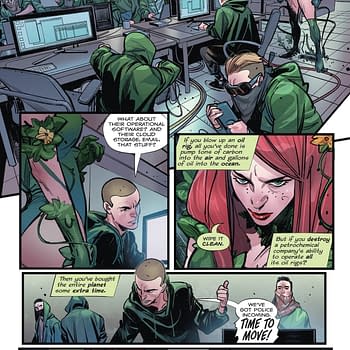Posted in: Comics, Recent Updates | Tagged: Alan Moore, Arthur Adams, Asbury Park Comic Con 2014, batwoman, Comics, dave stewart, dc comics, entertainment, greg rucka, J.H. Williams III, jack kirby, neil gaiman, promethea, sandman overture, todd klein, vertigo, warren ellis, wildstorm
Bleeding Cool Hosts J.H. Williams III Talking Process On Sandman: Overture And His Life In Art At Asbury Park Comic Con – With Full Audio
When I got an e-mail last January while traveling in the UK from Cliff Galbraith, one of the co-founders of Asbury Park Comic Con asking me if I would be interested in hosting a panel with J.H. Williams III in April, it took me approximately three seconds to reply, and the first two seconds were spent re-reading the e-mail assuming I must have misunderstood somehow what he was asking.
Then, a fair amount of terror set in since, like many of you, my personal fandom for Williams' work is such that it feels to me like he defines the aspirations of my generation in comics art. If I try to break it down logically, and that's difficult since my reactions to his work are so immediate, some of the things that render Williams such an artistic voice over the past twenty years are his ability to carry out seemingly impossible projects like Promethea, genre-changing projects like Batwoman, and consummate projects like Sandman: Overture that feel like an act of grace for fans, depicting worlds we simply never thought we would see by adding to our favorite mythologies. And that isn't even getting into the details of his actual visual style and the visionary nature of all of the panels and covers he's produced since he started work in the early 90's.
Another reason that it seemed miraculous that Williams would appear at a relatively new comic con in New Jersey is that the demands of his work on Overture have been even more all-consuming than he originally expected, with each issue proving quite a different story with elements of its own visual language necessary. And yet he did appear, and sign for fans on the con floor throughout Saturday and into Sunday before his panel, giving time to them in a very generous way.
I wasn't sure if the kinds of questions I was hoping to ask Williams were typical or strange, but in a fairly self-serving move, I picked were the ones that I simply wanted to hear him talk about. Sorry audience. Well, I don't think they minded. In fact, I realized with some relief that no matter what I did on stage, I really couldn't go wrong with J.H. Williams in the room.
We started off by talking about Williams' background in art, and what materials he's decided are most amenable to his work over time. He explained that though he's had "no formal training", taking two years of classes in advertizing art and design, taking a bus to his two-hour classes once a day had a big impact on him, not so much because of the technical skills he picked up, but because his teachers were very involved and emphasized the "idea behind the drawings" and forced him to confront the question: "What are you trying to say?" This really "opened his eyes" to the ways in which this "mode of thinking" could be applied to comics. He traces the "crazy layouts" that he's known for back to this influence.
The specific materials he now uses have come about through "trial and error" mostly, finding tools he liked, and though the only tool he's purposefully discarded is the quill pen (No way! He exclaimed, to the amusement of the audience), his quest for "the perfect paper" has been fairly all-consuming. This makes perfect sense, actually, if you know more about what Williams actually does when he's composing his work, as he explained a little later. Because he's "all over the place" with his tools, using pencils, inks, washes, and colored pencils, often in a single illustration, the paper he uses will simply break down and be unable to handle the mixed media, or react to one media in a way that destroys his efforts with another. Finding that perfect paper is still his white whale.
For his "tonal work", he prefers copic markers, he said. I asked him if making one mistake at one stage of his "layering" process means he has to go all the way back to the beginning and start again, but he quickly advised against that and explained that the only solution then is to "make mistakes not mistakes" and "find ways to live with it" and "tweak it" or else it would become an endless process. "I'm so slow, so damn slow", he said, laughing, because of what exactly he's "putting on the page". The reasons for this "slowness" are clearly not perfectionism, to judge from his account of "living" with mistakes, but instead the fact that he is the technician on every aspect of production, a process that usually involves several people. He's not "just a penciller", but a creator of "black and white paintings" when he's inking, and then there's the "tonal work" of colors. It's become his "bad habit" to be "one guy doing it all", but he still manages to produce 2 to 2 ½ pages a week in the process.
I asked Williams a little more about how he reached this point of multi-layered production, and he explained his development. When he was just penciling early-on, he reached a point where his wife advised him to start inking his own work, mainly because the visual cues he was trying to provide in his pencil work for the inker were taking him as long as inking the work himself would take in an effort to make sure that the inker didn't have to "read his mind". Arthur Adams, an artist he admired, inked his own work after all, and Williams felt this was the "next leap" he needed to make. It was a similar process deciding to move into colors. This enabled him to produce "singular vision" in his work, and also opened the door for more "experimentation". Not all experiments work, he commented, but it is a way to avoid stagnation. Some artists prefer to perfect a single style, he explained, like Arthur Adams, but his inclination is that he'd rather "dabble" and find "what the story needs". He admitted, "I have no idea how crazy things are going to get".
This seemed like a natural point to ask him about some of the double-page spreads in Sandman: Overture, crowded scenes with immense detail and heightened atmosphere. Williams said his strategy for handling large, crowded scenes is to create a visual narrative where a figure moves "through" the crowd, with smaller panels overlaid and depicting that movement. The image I showed him from Sandman: Overture contained about "30" versions of Dream, he said, though in reality, he informed us, there are over "50" total versions of Dream in issue #2 of the comic alone. There's one "crowd shot" and he "leads" the "action" through the scene.
One question I was fairly determined to ask was how on earth he came up with the visual design for so many distinct versions of Dream in the comic so far. He immediately corrected any misconceptions that he has a stack of "character sheets", 50 in number, with each version of Dream for reference. He "doesn't do character sheets", he explained, but "designs on the board" as he goes. Whatever "came to mind" made it into the differing versions of Dream that we see. I asked him if this meant that he was given the freedom to essentially create the versions of Dream in the crowd scenes without specific dictates in the script and he said that was correct.
There are a few "homages" present, Williams said, like a "Jack Kirby" Sandman. But the way that came about was that he provided a list, at Neil Gaiman's request, of the things he'd be most interested in drawing or including in the comic, and Gaiman has been assiduously "checking off" that list item by item. One of the entries on that list read "Jack Kirby". Gaiman is finding ways to reference Williams' preferences to bring them into the comic. One of the biggest items on the list for Williams was "Cats". At that request, the Cat version of Dream appeared and has become even more prominent in the comic.
Some of these versions of Dream may appear only once in the comic, but each has their own design and impact, like "Picasso Sandman", and they each "speak differently" too, I pointed out. Williams explained that sometimes the process in creating Overture works in its own layers including input from Gaiman, Williams, Todd Klein and Dave Stewart. For instance, after producing the crowd scenes of Sandmen, Gaiman and letterer Klein often went back and added dialogue for them suggested by their appearance. Todd Klein, who was in the audience at the panel, gave a friendly wave as we talked about his monumentally distinctive lettering and inventiveness.
That brought us to the subject of the central character Dream in Sandman: Overture and given the choices Williams had to make about designing each of 50 versions of Dream, I asked about how he decided on the appearance of 1915 Dream. Williams drew inspiration from the historical setting and plot, with the only request from Gaiman being that Dream's hair would be "shorter" this time around. Williams evoked the clothing of 1915 by looking at illustrations from the period, and realized that the appropriate thing would be for him to have "side burns" as a nod toward the typical "facial hair" of the era. But a more ethereal goal was to make this version of Dream "smoky", or at least "somewhat smoky". He also wanted to bring back the "flame details" on Dream's robes, but took the feature to its logical extreme by suggesting that there should "actually be fire" issuing from his robes. And along those lines, he also wanted to create a "smoky, washy effect" by showing the "edge of background creeping through" the hems of his robes to suggest that in some ways, as Dream, he was "not quite there".
It would have been very, very easy to talk about Sandman: Overture for the entire length of the panel, but I tried to step back from what were to me fascinating insights into the design of the book and characters in order to talk about Williams' wider career. I suspected correctly that there were plenty of fans of Batwoman in the audience hoping he'd say a little about his work on superhero comics. I asked him if his extensive work with superheroes as an artist was born from a personal inclination to draw superheroes, but he replied that it actually hasn't come about from a "distinct interest in superheroes" though he is very much interested in them as a "modern mythology". Instead, it's the allure of a "good story" that drives him and certainly "heroic mythic fiction" attracts him rather than superheroes per se. He feels he's "moved more toward that" interest, in fact, in Sandman: Overture. Likewise in Promethea. He also has a very specific interest in crime fiction, as we can see in Desolation Jones with Warren Ellis. He feels that comics have "more to offer" than just superhero stories and that even when working with superheroes, he's "pulling from different sources" that are not just superhero tradition as part of his "creative process".
I asked him if Promethea was a developmental experience for him, working on his first really long series as an artist, and he agreed that he "needed that to happen" to "grow" in many ways, and moved into simply "appreciating art" during that time, willing to try "this and that" in order to be "challenged". Working with Alan Moore, particularly, challenged him to do just that. The "middle section" of Promethea, he said, the Kabbalah Quest, where each story and "world" would differ in "style" encouraged him to "try anything" because comics "can be anything". When he feels he's approaching something that "can't be done", he said, he goes "right over the cliff" beyond that limit. The dominant double-page spreads in Promethea that he's now so known for have inspired the format of the forthcoming "widescreen" edition of the series presented in horizontal landscape format, where "double pages" will now be read as "single pages". This is something he feels has "never been done before", a "new format" for reading comics. The remastering of the series has resulted, of course, in new work for him to do, though, including the equivalent of 8 covers due to the slipcase for the edition. For Williams, this is a "month" of solid work needed. Issue #12 will be presented as an "accordion fold out" as it was originally intended to be, a format that's a "game changer".
I brought up Batwoman as a comic that also shows his ability to alter expectations in superhero comics, like drawing on folk-tales more fully as both writer and artist. Williams said that Greg Rucka's introduction of "supernatural elements" in the character's origin in Detective Comics allowed him more freedom to do that, but he feels that Gotham City and the whole DCU is, in fact, an environment where "any weird stuff can happen" with many possibilities for storytelling. He decided to "mix genres further" with each arc, bringing them into superhero comics, something that's more possible in long-running arcs. She fights a "ghost" at one point, for instance, and there's also a James Bond-like plot, as well as "classic fantasy". But the key, for Williams, is also recognizing that she's a "human" character, a "normal human being" with a home life, and emphasizing those elements makes it easier to "believe more in myth" in the story by grounding it.
Our time was winding down for the panel, so I asked Williams to talk about his recent work on album and CD covers, and his own music fandom. For followers of his work, this may seem like a recent development, but he explained that he's wanted to do album work for some time and hoped for opportunities to pursue that. Regarding The Sword, he received an e-mail from the group who were already comics fans and very much "open" to what he wanted to do.
Though his work for The Sword is actually out already, his work for Blondie pre-dates that but is still forthcoming. As a longtime fan attending a show with VIP tickets, and hearing that the group liked comics, he brought a copy of Batwoman to show them in a pre-show discussion. He knew he was "throwing" himself "out there" to do it, but that is his typical mode, he laughed. After the show, he learned that they had read the comic during the opening act, and were already onboard, almost immediately offering for him to do the cover to their next album. This was massively rewarding for Williams to be working in tandem with his favorite band and he really can't wait for the album to finally be released in shops. They've allowed him to bring "storytelling" into the artwork on the album, and "make a narrative" out of it, an unusual thing for the band to give him so much freedom to create.
We had a short Q&A at the end of the panel, and audience members asked Williams how he designs characters more generally to make them feel so real to readers, and he replied that if he doesn't already view the characters as "existing people" whose appearance is going to fit their personality, then he feels there's something "wrong with the character". Believing in their reality is key to their visual design.
One fan, of course, asked what the schedule will be like for the release of future issues of Sandman: Overture, and Williams explained that the visual development of the series has expanded, with the "issues all quite different" in feel. That, of course, takes a lot of work and time, and he intends to "find ways to do his best" under the circumstances. He finds the fact that Dream is a "legacy character" a bit daunting at times, and that means he definitively does not want to "short change the story" by bringing any less to the project. But one thing he particularly loves about working on Sandman: Overture is that more than any other Sandman arc so far, Morpheus appears nearly "on every page" so he, as an artist, gets to spend more time with Dream than anyone else, really.
And here's full audio of the event:
[youtube]https://www.youtube.com/watch?v=YPDVtt4sXss[/youtube]
Hannah Means-Shannon is EIC at Bleeding Cool and @hannahmenzies on Twitter



























